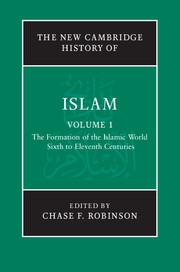Book contents
- Frontmatter
- Introduction
- PART I THE LATE ANTIQUE CONTEXT
- PART II UNIVERSALISM AND IMPERIALISM
- 5 The rise of Islam, 600–705
- 6 The empire in Syria, 705–763
- 7 The empire in Iraq, 763–861
- 8 The waning of empire, 861–945
- 9 The late ʿAbbāsid pattern, 945–1050
- PART III REGIONALISM
- PART IV THE HISTORIOGRAPHY OF EARLY ISLAMIC HISTORY
- Conclusion: From formative Islam to classical Islam
- Glossary
- Bibliography
- Index
- Plate Section
- References
7 - The empire in Iraq, 763–861
from PART II - UNIVERSALISM AND IMPERIALISM
Published online by Cambridge University Press: 28 March 2011
- Frontmatter
- Introduction
- PART I THE LATE ANTIQUE CONTEXT
- PART II UNIVERSALISM AND IMPERIALISM
- 5 The rise of Islam, 600–705
- 6 The empire in Syria, 705–763
- 7 The empire in Iraq, 763–861
- 8 The waning of empire, 861–945
- 9 The late ʿAbbāsid pattern, 945–1050
- PART III REGIONALISM
- PART IV THE HISTORIOGRAPHY OF EARLY ISLAMIC HISTORY
- Conclusion: From formative Islam to classical Islam
- Glossary
- Bibliography
- Index
- Plate Section
- References
Summary
The consolidation of power
Although the Umayyad dynasty fell rapidly in the face of the Hāshimite–Khurāsānī revolution in 132/750, the ʿAbbāsid dynasty’s hold on power took until 145/762 to become firmly established. The second ʿAbbāsid caliph, Abū Jaʿfar al-Manṣūr (r. 136–58/754–75), rightly recognised by historians as the real founder of the ʿAbbāsid state, was well aware, immediately after his accession to power, that he had to subdue a range of the revolution’s heroes if the caliphate was to remain in his family line. His first political move in 754 was to force the allegiance of his uncle, ʿAbd Allāh ibn ʿAlī, thereby redefining the hierarchy within the ʿAbbāsid house. This step was quickly followed by the overthrow of Abū Muslim al-Khurāsānī. In spite of his outward loyalty to the Hāshimite family, Abū Muslim commanded popular support in Khurāsān as an Iranian political leader, and to some he resembled a messianic figure. The latter aspect became apparent only after his downfall, when a series of rural rebellions, collectively known as the ‘Abū Muslimiyya’ revolts, sprang up in Khurāsān, challenging ʿAbbāsid rule. Although these heterodox (ghulāt) rebels did not seriously threaten the ʿAbbāsid state, they did point to both the lingering hope for an Iranian revival and a syncretistic belief in continuous prophecy, which at that juncture included such beliefs as Abū Muslim’s occultation, reincarnation and future return.
Keywords
- Type
- Chapter
- Information
- The New Cambridge History of Islam , pp. 269 - 304Publisher: Cambridge University PressPrint publication year: 2010
References
- 3
- Cited by

